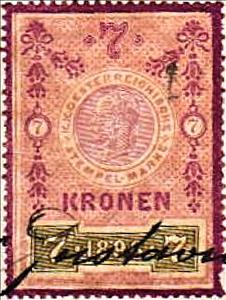Stamp: Stempel Marke 1898 7 krone (Austria 1898)
Stempel Marke 1898 7 krone (Austria 1898)
01 October (Austria ) within release Revenues : Stempelmarke 1898 goes into circulation Stamp Stempel Marke 1898 7 krone face value 7 Austro-Hungarian krone
| Stamp Stempel Marke 1898 7 krone in catalogues | |
|---|---|
| POFIS: | POF: AT KZ427I |
Stamp is vertical format.
Type I: "7" below curved, looks like an inverted 2. 13th issue. Perforation can be line or comb 12 1/4 - 14. The so-called "decal principle" was used, which was supposed to increase the security of the stamp against forgery and reuse. Underprint of stylized stars in the color brownish purple. Revenue stamps were printed four times. First, underprint in the first thin layer of glue on the reverse side, then print the image, then print the raster frame in the lower part of the stamp, where the nominal value and year are located, and finally print the colored frame around the revenue stamp. For this issue, there are many color shades of image printing, frame printing around the stamp. The colors are sometimes significantly different, especially the colors of the frames around the stamp. __ ! ! ! Stamps of this issue must not come off in water because it would be removed or seriously violate the underprint! They are collected only on documents or clippings ! ! !Stamp Stempel Marke 1898 7 krone it reflects the thematic directions:
A head of state (or chief of state) is the public persona that officially represents the national unity and legitimacy of a sovereign state. In some countries, the head of state is a ceremonial figurehead with limited or no executive power, while in others, the head of state is also the head of government. In countries with parliamentary governments, the head of state is typically a ceremonial figurehead that does not actually guide day-to-day government activities and may not be empowered to exercise any kind of secular political authority (e.g., Queen Elizabeth II as Head of the Commonwealth). In countries where the head of state is also the head of government, the president serves as both a public figurehead and the actual highest ranking political leader who oversees the executive branch (e.g., the President of the United States).
A number is a mathematical object used to count, measure, and label. The most basic examples are the natural numbers 1, 2, 3, 4, and so forth. Numbers can be represented in language with number words. More universally, individual numbers can be represented by symbols, called numerals; for example, "5" is a numeral that represents the number five. As only a relatively small number of symbols can be memorized, basic numerals are commonly organized in a numeral system, which is an organized way to represent any number. The most common numeral system is the Hindu–Arabic numeral system, which allows for the representation of any non-negative integer using a combination of ten fundamental numeric symbols, called digits. In addition to their use in counting and measuring, numerals are often used for labels (as with telephone numbers), for ordering (as with serial numbers), and for codes (as with ISBNs). In common usage, a numeral is not clearly distinguished from the number that it represents.


